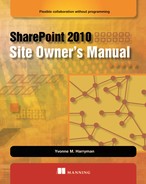Table of Contents
1. Getting started with SharePoint
Chapter 1. Leveraging the power of SharePoint
1.2. SharePoint sample (Hello World)
Chapter 2. A deeper dive into SharePoint capabilities
2.1. Introducing SharePoint 2010
2.1.1. SharePoint’s six core capabilities
2.1.2. SharePoint Foundation functionality
Chapter 3. Creating sites using site and list templates
3.1. Building templates with the different SharePoint editions
3.2. Core list and library templates
3.2.1. Document Library template
3.3. Learning about the site templates
3.3.2. SharePoint Foundation collaborative site templates
3.3.3. SharePoint Foundation meeting site templates
3.3.4. Out-of-the-box site templates for SharePoint Server
3.3.5. SharePoint Server Standard templates
2. Implementations using real-world scenarios
Chapter 4. Setting up a document collaboration site
4.1. Managing business proposal resources
4.2. SharePoint Foundation features
4.2.2. Contacts list: tracking the human resources
4.2.3. Document libraries: managing the proposals and resumes
4.3. SharePoint Server features
Chapter 5. Leveraging enterprise content management features
5.1. Managing business proposal resources
5.2. SharePoint Foundation features
5.2.1. Content types: associating metadata with certain content
5.3. SharePoint Server features
5.3.1. Retention plan: creating an information management policy
Chapter 6. Publishing information to the web
6.1. Determining what information to make available for your guests
6.2. Setting up a SharePoint site for the internet
6.3.1. Site pages: defining the information you want to share
6.4. Blogs: creating a subsite to blog
6.5. Permissions: managing access to your site
6.6. Taking it further with SharePoint Server
Chapter 7. Empowering users with business intelligence
7.1. Determining what information to make available for your guests
7.2. Setting up a SharePoint Business Intelligence Center
7.3. Creating your data source
7.4. Configuring your Business Intelligence Center
Chapter 8. Creating application sites with SharePoint Designer
8.1. Gathering certification status
8.2. Using SharePoint Designer with SharePoint Foundation
8.2.1. Creating your Foundation site
8.2.2. Custom list: creating a data store of current projects
8.2.3. XSLT List View web part (LVWP): displaying Microsoft Certified Technology Specialist
8.2.4. Default workflows: creating an approval process
8.2.5. Item-level permissions: configuring the items users can manage
8.3. Leveraging SharePoint Server to take it further
Chapter 9. Collecting and managing data by integrating with InfoPath
9.1. Gathering employee feedback
9.2. Using InfoPath with SharePoint Foundation
9.2.2. Custom list: creating a data store of current projects
9.2.3. Forms library: creating a library to manage the feedback form
9.2.4. InfoPath: creating your feedback form
9.2.5. InfoPath workflow: configuring how users see the data
9.3. Leveraging Forms Services with SharePoint Server
Chapter 10. Reporting and web applications using Access
10.1. Managing hardware reservations
10.2. Leveraging Access with SharePoint Foundation
10.2.1. Creating your Foundation site
10.2.2. Custom list: creating a data store to manage clients, hardware, and reservations
10.2.3. Linked tables: pulling the data into Access
10.2.4. Client query: integrating the data in the different tables
10.3. Using Access Services with SharePoint Server
10.3.1. Local tables: managing the data in Access
10.3.2. Web forms: entering data using a web form
10.3.3. Web query: generating a web query
10.3.4. Web reports: generating reports to see reservations by type and client
10.3.5. Navigation web form: tying your reports and forms together
Chapter 11. Pulling it all together with search, My Sites, and cross-site functionality
11.2. Cross-site configurations
11.3. Site collection administrator capabilities
11.3.1. Information architecture
11.4.2. Working with your colleagues
11.4.3. Setting your interests
Appendix A. Setting up a test environment
A.1. Ensuring your computer meets the requirements
Appendix B. Creating your first site
B.1. Initial creation of your site
